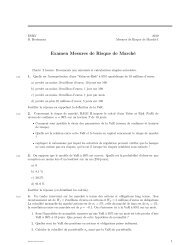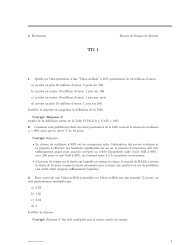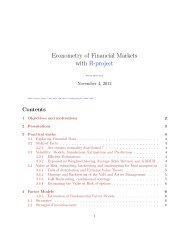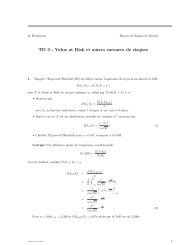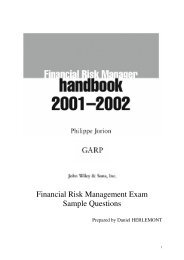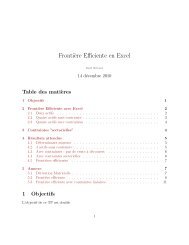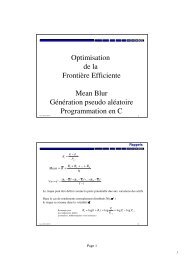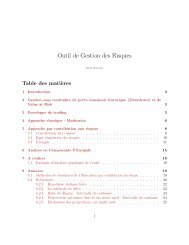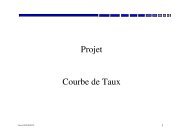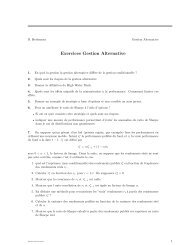Create successful ePaper yourself
Turn your PDF publications into a flip-book with our unique Google optimized e-Paper software.
<strong>Daniel</strong> <strong>HERLEMONT</strong><br />
chemin du guerrier,<br />
31450 Deyme FRANCE<br />
���� +33 (0) 6 10 48 02 99<br />
mailto:dherlemont@yats.<strong>com</strong><br />
born: 1955<br />
language: French, English<br />
EDUCATION :<br />
1993-1994: MBA - CPA (Centre de Perfectionnement aux Affaires, Groupe Lagardère)<br />
1979-1981: Graduated from "Ecole Supérieure d'Electricité"<br />
1976-1979: Graduated from Ecole Polytechnique (X76)<br />
EXPERIENCE (summary) :<br />
1998 - ... Professor of Finance at Mathematical Finance School of Léonard de Vinci, Paris La Défense<br />
Risk Manager for a Hedge Fund<br />
Lecturer in Business Schools and Universities for Master in Finance: Toulouse Business<br />
School and University, Poland, …<br />
YATS: consulting services and solutions for e-business applications, including:<br />
• a powerful automated trading platform and systems, for real time execution, simulation<br />
and training, featuring statistical arbitrage and artificial intelligence based strategies,<br />
• advanced risk management and Optimization tools for Hedge Funds<br />
• Information systems for on line trading, front, middle and back office applications,<br />
development, integration and operations of advanced search engines, integration of real<br />
time quotes and news feeds, decision aid tools ...<br />
Main references :<br />
2002-... : teaching, risk management for Hedge Funds, proprietary trading, ...<br />
1999-2002: Société Générale (FIMATEX): developing & hosting news feeds, search engines &<br />
online tools (warrants, opinions, profiling, ...)<br />
1999-2001: WARGNY: internet architecture, development of online decision aids,<br />
1998-1999: creation of yats.<strong>com</strong>, ranked as one of the most attractive financial site.<br />
1987-1998 ASTRIUM (ex MATRA MARCONI SPACE) the Europe’s largest space <strong>com</strong>pany, Toulouse<br />
• 1998-1994 Deputy Manager of Ground Systems & Network Unit (300 engineers), including<br />
diversification in satellites applications: telematics, environment monitoring, Air Traffic<br />
Management, telemedicine, .....<br />
• 1991-1994: Manager of the "Technologies & Innovation" division (60 engineers)<br />
• 1987-1991: Manager of the Control Centre division (50 engineers).<br />
1981-1987<br />
THOMSON-CSF / Central Research Labs: development of operating system and object oriented<br />
middleware <strong>com</strong>ponents RISC microprocessors (within a Joint-Venture with MIPS inc., USA).<br />
YATS SARL, 440 653 285 RCS Toulouse , chemin du guerrier 31450 DEYME email : dherlemont@yats.<strong>com</strong>
Risk Management Philosophy<br />
By <strong>Daniel</strong> <strong>HERLEMONT</strong>, YATS Finances & Technologies<br />
Risk Model: Implementing Safety First Principle<br />
Risk Management may be the most important element of an<br />
investment process. Risk Management is the key to surviving<br />
during inevitable, dramatic market moves.<br />
Market risk is the risk of losses due to the financial market<br />
variables (such as interest rates, foreign currency, equities,<br />
and <strong>com</strong>modities) adverse<br />
prices fluctuations. It is<br />
primarily measured with<br />
Value at Risk or VaR.<br />
VaR is a statistical<br />
measure of downside risk<br />
that is simple to<br />
implement. VaR<br />
measures the maximum<br />
loss for a given confidence interval.<br />
VaR model is primarily based on Risk Management<br />
Standards such as RiskMetrics and Risk Management<br />
Guides (from JP Morgan) as well as Basle II<br />
re<strong>com</strong>mendations.<br />
VaR, however, is not the only risk measure that YATS uses.<br />
VaR is <strong>com</strong>plemented by Stress Testing which identifies<br />
potential losses under extreme market conditions. YATS<br />
Market Risk model also implements Extreme Values theory<br />
to provide more robust estimates of VaR. Other risk<br />
measures are extensively used such as Maximum Drawdown<br />
analysis, Conditional VaR, Risk Adjusted Performance<br />
Measures such as Omega measures, and Stutzer Index. The<br />
Stutzer Index is a consistent generalization of the Sharpe<br />
Ratio for fat tails returns and prudent investor, implementing<br />
a Safety First Principle. The Stutzer Index has been recently<br />
adopted by Morningstar.<br />
Risk measures and preferences will be used to determine<br />
trading limits, position sizing and stop losses as well as<br />
optimal leverage to meet risk management constraints such<br />
as VaR and Maximum Drawdown objectives while<br />
maximizing the expected growth rate. More precisely, the<br />
leverage is adjusted to maximize the expected growth rates<br />
under the constraints that a VaR or Maximum Drawdown<br />
objective will be satisfied with a predefined high probability<br />
level. When this probability is set to 1, then the policy is the<br />
same as implementing strict portfolio insurance. However,<br />
strict guarantee may be too restrictive. In a more general<br />
setting, with a probability, of say 95%, the trader will have<br />
more flexibility to capture opportunities in specific market<br />
states.<br />
YATS, <strong>Daniel</strong> <strong>HERLEMONT</strong>, Tel +33 (0) 6 10 48 02 99 email: dherlemont@yats.<strong>com</strong><br />
YATS Risk Model: the actual implementation<br />
YATS Risk Management duties generally include:<br />
• Modeling traded assets, historical distributions, extreme<br />
events and, most importantly, the dynamic strategy<br />
• Defining the most suited Volatility models to implement a<br />
dynamic VaR that may depend on the different market<br />
regimes; typically, this model will dictate to reduce<br />
positions when volatility increases dramatically<br />
• Back testing the monthly VaR to meet a typical objective of<br />
a 95% VaR not exceeding 4% of the capital<br />
• Implementing Conditional VaR to avoid some VaR<br />
short<strong>com</strong>ings (see hereafter)<br />
• Implementing a Safety First Principle at strategy level by<br />
optimizing the Stutzer Index,<br />
• Implementing overall optimal allocation and leverage under<br />
the VaR and Drawdown constraints<br />
• Performing extensive scenario and stress testing<br />
The positions are monitored on a daily basis and mark to market VaR<br />
is provided as well as other parameters <strong>com</strong>puted such as VaR<br />
exceptions. Regular and <strong>com</strong>prehensive Risk reports are directly sent<br />
to clients.<br />
Market<br />
Insight and<br />
objectives<br />
scénarii<br />
Trader<br />
Risk Manager<br />
Optimal Leverage<br />
Stop loss and<br />
Position sizing<br />
Trading<br />
Positions<br />
Monitoring & Control<br />
safety rules enforcements
Return<br />
-0.6 -0.4 -0.2 0.0 0.2<br />
Risk Management Philosophy<br />
By <strong>Daniel</strong> <strong>HERLEMONT</strong>, YATS Finances & Technologies<br />
Value at Risk and Beyond<br />
While there is no doubt that VaR is a useful generic measure<br />
of risk exposure, VaR has a number of limitations that are<br />
particularly problematic for hedge-fund investments. In<br />
addition, VaR tells noting about actual losses… Other Risk<br />
measures, such as the Conditional VaR or CVaR, have not<br />
the short<strong>com</strong>ing of the VaR. The CVaR measures the<br />
expected loss conditional on the loss being greater than or<br />
equal to the VaR. By using the CVaR, we are able to capture<br />
the left-tail risk of those hedge fund strategies that have short<br />
put option-like exposures. The VaR might be blind on actual<br />
losses. In addition the CVaR can be used in optimization<br />
programs, which is not possible with VaR or may lead to<br />
risky positions if the investment process is tailored to trade<br />
at the VaR boundaries under fat tailed returns.<br />
Nearly all hedge fund strategies show fat tails (negatively<br />
skewed return distributions with positive excess kurtosis).<br />
The efficient frontier is changed when using modified VaR<br />
rather than VaR as the risk constraint. Application of the<br />
mean-variance framework in the case of some hedge fund<br />
strategies can result in underestimation of tail risk by as<br />
much as 50%.<br />
Leverage will determine the ongoing viability of the<br />
program.<br />
One can build a business or investment program around<br />
positive expected value opportunities, but the particular<br />
leverage level and hedging strategy chosen will determine<br />
the ongoing viability of the program. There are well known<br />
examples of statistically valid strategies resulting in billions<br />
of dollars of losses (Metallgesellschaft in 1993, Long Term<br />
Capital Management in 1998…). Obviously, the leverage<br />
level and hedging strategies chosen were flawed. When<br />
choosing too much leverage, an investor sometimes faces the<br />
problem of possibly being able to win the “game”, but<br />
consistently running out of time.<br />
In a multi-periods<br />
setting, the typical<br />
growth of the wealth<br />
does not linearly depend<br />
on the leverage. Rather,<br />
the dependency can be<br />
approximated by the so<br />
called Kelly parabola.<br />
There exists an optimal<br />
leverage that will lead<br />
the best growth.<br />
0.0 0.5 1.0 1.5 Exceeding this optimal<br />
Leverage<br />
leverage may lead to<br />
dramatic losses.<br />
Misunderstanding the leverage effects explains the high level<br />
of mortality in the Hedge Fund industry (15%-20% default<br />
rate per year)<br />
Risk Adjusted Performance Measure: a Safety First Principle<br />
The Sharpe ratio is certainly one of the most popular Risk Adjusted<br />
Return Measure. However, several authors have pointed out the<br />
short<strong>com</strong>ings of using the Sharpe ratio. As a matter of fact, one can<br />
define an optimal strategy maximizing the Sharpe ratio in <strong>com</strong>plete<br />
and arbitrage-free markets. This strategy mainly consists in selling<br />
put options far out of the money. This returns distribution of this<br />
strategy has a truncated right tail and an elongated left tail. It is well<br />
known that this type of strategy may lead to rare but dramatic losses.<br />
Using the Sharpe ratio to evaluate risk premia strategies will create<br />
the same type of problems as with option sellers. Hence, by<br />
undertaking a maximum Sharpe ratio strategy, an investor may be<br />
accepting very risky investments in exchange for improving the mean<br />
or variance of the investment. The problem with this trade-off is that<br />
investors are risk averse; they most certainly have a preference for<br />
upside risk and an aversion to downside risk.<br />
The Stutzer Index does not suffer the Sharpe Ratio short<strong>com</strong>ings.<br />
The main concern for investors is the probability of underperforming<br />
a benchmark on average. The Stutzer index rewards those portfolios<br />
that have a lower likelihood of underperforming a specified<br />
benchmark on average. This measure penalizes negative skewness<br />
and high kurtosis (for given levels of mean returns and variance).<br />
The Stutzer index is reduced to the Sharpe Ratio when return<br />
distributions are normally distributed. Equivalently, we can use the<br />
Hodges Generalized Sharpe Ratio that has the same properties as the<br />
Stutzer Index. The higher it is, the better is the portfolio.<br />
Unveiling Dependencies<br />
An important selling point for alternative investments is their<br />
typically low correlations with traditional market indexes such as the<br />
S&P500. However, correlations are linear measures of association<br />
that ignore certain nonlinear relations often present among hedgefund<br />
investments. Nonlinearities should be incorporated into any risk<br />
analysis of hedge fund investments. Rather than using conventional<br />
linear correlation measures, we are using non linear regressions as<br />
well as non conventional measures like relative entropy that is much<br />
more robust a measure based on information theory.<br />
Incentive Contracts and Hedge Fund Management<br />
Hedge fund managers typically receive a fraction of the fund’s return<br />
in excess of the high-water mark. The high-water mark for each<br />
investor is the maximum share value since his or her investment in<br />
the fund. These performance fees generally range from 15% to 25%<br />
of the new profits earned each year. Option-like characteristics of<br />
incentive fees clearly could induce risk-taking behavior when the<br />
asset value is below the high-water mark. This “option like” payoff is<br />
taken into account in overall integrated risk model so that the risk<br />
behavior of the investment manager is under control and restricted to<br />
meet investors’ objective rather than the manager‘s objective only.<br />
YATS, <strong>Daniel</strong> <strong>HERLEMONT</strong>, Tel +33 (0) 6 10 48 02 99 email: dherlemont@yats.<strong>com</strong>
YATS-RAPT : Real-time Automated Profitable Trading<br />
YATS-RAPT offers professional solutions to develop, test and<br />
operate automated trading systems for futures and stock<br />
markets.<br />
The YATS-RAPT plateform is a result of more than 15 years<br />
endeavor in <strong>com</strong>putational finance, development and actual<br />
trading on futures and stock markets.<br />
YATS- RAPT runs on any<br />
environment : WINDOWS, LINUX, ...<br />
Actual operation on going, with more<br />
than 50 orders / day.<br />
100 000 of source lines code.<br />
Commercial offering<br />
Trading Systèm<br />
YATS <strong>com</strong>ponents<br />
JAVA, JAVASCRIPT, DDE .NET bridge<br />
Interactive Brokers TWS,<br />
FIX protocol,<br />
Web brokers interface<br />
• Automated orders with Interactive Brokers , FIX interface, WEB<br />
broker interface.<br />
• Dynamic tables, real time charts<br />
• User defined strategies in JAVASCRIPT,<br />
• Errors controls, automatic re-connection,<br />
• Tick by tick Recording, order logs, portfolios,<br />
• Operating modes: actual trading, live test, training, debug,<br />
simulation, backtest, studies ...<br />
• High fidelity simulator: on recorded or simulated ticks, variable<br />
speeds, simulate order book using full tick data (bid/ask/last), as well as<br />
order priorities (bid/ask/last sizes) and transmission delays, ...<br />
• Trading Systems Debugger including, event breakpoint (order status,<br />
tick data, ...), step by step mode.<br />
• Trading Systems Backtester including parameters optimizations<br />
based on user defined objective functions (reward/risk)<br />
• Support for execution of parallel multiple strategies.<br />
• More than 100 Indicators : technical analysis, many math, logical<br />
functions on intraday data, in tick time, or business time, aggregation of<br />
ticks data in regular time series, user defined functions/indicators in<br />
JAVASCRIPT.<br />
• Volatility models, covariances, using high/low values, ACD-CARGH<br />
modeling,<br />
• Risk, money management : Sharpe ratio, Sterling ratio, VaR, utility<br />
functions,...<br />
• Portfolio management: CAPM, optimization of user defined utility<br />
function, Kelly criteria, CRP (Constant Rebalanced Portfolio), ....<br />
• Options pricers :, classic or exotic options<br />
• Numerical analysis: global optimizations (simulated annealing), genetic<br />
algorithms, Kalman filtering, wavelets, ...<br />
• Monte Carlo Simulations, (MCMC)<br />
• Probability & Statistics, significance testing : t-stat, khi2, Kolmogorov<br />
Smirnov, Watson, Jarque Berra, runs test, linear and non linear<br />
simple/multiple regressions, maximum likelihood, bootstrap, time series<br />
analysis: ARIMA, VARMA, stochastic processes and related<br />
distributions (min/max, first passage time, ...),<br />
• Variable length Markov Chains<br />
• Machine learning, data mining: classification, segmentation, non<br />
linear regressions (KNN, ...), regression trees, dynamic programming,<br />
reinforcement learning, universal predictions & portfolios<br />
• predefined and fully parameterizable Trading Systems<br />
momentum, trend following, mean reversion, breakout,<br />
long/short positions ....<br />
• Stat arb trading systems : based on cointegration<br />
VAR/VECM & Kalman filter<br />
• Market Making algorithms<br />
• "Model Based Trading"<br />
data → model → Monte Carlo Simulation of market<br />
model → Optimal Trading System<br />
WEB interface can be used for modeling and backtests.<br />
orders<br />
quotes actual simulated<br />
actual actual trading (live) test, training<br />
recorded or<br />
simulated<br />
Real time charts<br />
Operating Modes<br />
YATS SARL, 440 653 285 RCS Toulouse , chemin du guerrier 31450 DEYME email : dherlemont@yats.<strong>com</strong><br />
training, debug, simulation,<br />
backtesting,<br />
Trading Automata state machine
Computational Finance<br />
Success in the markets will depend on having superior models and algorithms ..<br />
.<br />
During the last 15 years, I studied intensively all aspects of<br />
research in finance with the objective to implement superior<br />
trading algorithms, focusing on the most promising areas:<br />
• Behavioral Finance : deviation from the efficient market<br />
hypothesis stems from behavioral biases and models based<br />
on herding, loss aversion, information flow, sector<br />
rotation, etc ... such behaviors is the source of repeated,<br />
robust and persistent patterns explaining most of market<br />
anomalies, market bubbles and crashes.<br />
• Computational finance, defined as the application of<br />
modern techniques in <strong>com</strong>puter science, mathematics and<br />
statistics to solve <strong>com</strong>plex problems in finance.<br />
• Model based trading consists in modeling markets data<br />
and finding optimal trading systems by Monte Carlo<br />
simulation on model generated data.<br />
Even if most subjects are still active research efforts, they are<br />
integrated within the YATS environment and used to trade<br />
actual markets.<br />
Keywords : Data Mining and Knowledge Discovery, Natural<br />
Language Processing and Information Extraction, Machine<br />
Learning, Pattern Recognition, Genetic and Evolutionary<br />
Computing, Simulation and Monte Carlo.<br />
More specifically, I studied and implemented online<br />
algorithms<br />
• to perform online and real time arbitrage, using<br />
multivariate cointegration and filtering (Kalman filter)<br />
• Non parametric techniques for pattern recognition, like<br />
Variable Length Markov chains<br />
• Reinforcement learning algorithms (Q-learning, TDlearning):<br />
• Wavelets, to identify long term dependencies,<br />
• Universal Online prediction techniques (quite similar to<br />
<strong>com</strong>pression algorithm), universal portfolios, ...<br />
• Methodology to avoid data snooping and overfitting<br />
Some other subjects: I studied and implemented: probabilities,<br />
approximations (Edgeworth, ..) extreme value theory (Cramer,<br />
...), Time Series Analysis (AR, MA, ARIMA, ..), non<br />
parametric methods (gaussian kernels, KNN, LWR, ...),<br />
bayesian learning, chaos (BDS tests), fractals (Hurst<br />
exponents, ...), Markov chains, information theory (relative<br />
entropy), estimation procedure: maximum likelihood, global<br />
optimization (simulated annealing, ...), game theory (Minority<br />
Games, ...), stochastic processes, including first hitting time,<br />
distribution of minimum and maximum, volatility modeling<br />
(GARCH, ..) and estimation using highs and lows, higher<br />
moment estimates, kurtosis/herding, skews /crashes, intraday<br />
modeling : intensity, ACD models, cointegration, Dickey-<br />
Fuller, VAR/VECM, Kalman filter, utility functions, CAPM,<br />
Arbitrage Pricing Theory, VaR, optimal portfolio and<br />
leverage, options pricing (including exotic options), dynamic<br />
programming & optimal control, ...<br />
Natural Language Processing (NLP) can be used as a<br />
support tool. For example, YATS search engines can be<br />
used to screen internet and derive opinions on stocks,<br />
market sentiment, detect rumors like merger, summarize<br />
news, count occurrences of stocks in the press, in forums,<br />
etc .... and to exploit information flow delays or well<br />
known behavioral biases, like popular blueships<br />
experienced more severe crashes than less popular stocks.<br />
Some selected references / authors:<br />
• Jean-Philippe Bouchaud, Marc Potters, 2000, Theory<br />
of Financial Risks, Cambridge University Press,<br />
• Merton, Robert C., 1992, Continuous Time Finance.<br />
• W. Feller, 1997, An introduction to probability theory<br />
and its applications, Vol I & II, second edition - John<br />
Wiley and sons, New York<br />
• Karatzas and Shreve, 1988, Brownian motion and<br />
stochastic calculus, Springer Verlag<br />
• Andrew W. Lo and A. Craig A Non-Random Walk<br />
Down Wall Street<br />
• Grinold, Active Portfolio Management,<br />
• Ralph Vince, 1990, Portfolio Management Formulas,<br />
• Journal Of Finance, Quantitative Finance,<br />
• Behavioral finance literature: R. Thaler, D.<br />
Kahneman, Odean, Chen, M. Rabin, R. Shiller, ...<br />
• and many other authors and references that is not<br />
possible to list here ...<br />
Articles/Authors:<br />
• Rama Cont : stylized facts, herding models, ...<br />
• JP Bouchaud: numerous articles on risk management,<br />
derivatives, market modeling<br />
• Didier Sornette one of the best and most productive<br />
author in "econophysics", specially on crahs<br />
modeling, extreme events modeling, portfolio<br />
management using higher order moments,<br />
• Farmer, Lux, for agent modeling,<br />
• other "econophysics" authors: Maslov, Baviera,<br />
Mantegna, ...<br />
• Ait-Sahalia<br />
• Thomas Cover (Information theory, universal<br />
portfolio)<br />
• Alexander (cointegration), Hasbrouck (intraday<br />
modeling), .<br />
• learning to trade: Moody, Dempster, Jones<br />
In French:<br />
• Denis Bosq, Jean Pierre Lecoutre, 1992, Analyse et<br />
prévision des séries chronologiques, méthodes<br />
paramétriques et non paramétriques, Masson,<br />
• Cours Polytechnique et DEA Probabilités et Finance<br />
Paris VI (El Karoui)<br />
• Rochet, J-C. et G. Demange, 1992, Méthodes<br />
Mathématiques de la Finance, Economica,<br />
• Autres auteurs: Jean Jacques Laffont, Christian<br />
Gourieroux, ...<br />
Mastering C++, JAVA, R-project, Latex, VBA/Excel, ...<br />
YATS SARL, 440 653 285 RCS Toulouse , chemin du guerrier 31450 DEYME email : dherlemont@yats.<strong>com</strong>
TECHNOLOGIES<br />
Developed up to now (June 2003).<br />
more than 300 000 source lines codes<br />
in JAVA, mastering all JAVA packages, including:<br />
• user interface (SWING),<br />
• graphics and imaging (JAVA2D),<br />
• data bases Interfaces (JDBC),<br />
• network and I/O, RMI, new io package<br />
• security, SSL programming.<br />
• naming<br />
• XML<br />
J2EE:<br />
• Servlets and JSP.<br />
• Enterprise JavaBeans (EJB)<br />
• Java Message Service (JMS)<br />
• Java Mail<br />
• Management / JMX<br />
• Security (JAAS)<br />
Mastering related open source products:<br />
• JAKARTA / Apache suites : TOMCAT (Web<br />
server), JAMES (SMTP, POP3, NNTP server),<br />
TURBINE (servlet framework), JETSPEED<br />
(Enterprise Information Portal)<br />
• Scripting facilities (BSF/ Javascript/JPython)<br />
• XML: Apache (Xerces, COCOON, ...),<br />
• JBOSS, a J2EE,server, featuring JMX, JMS,<br />
• ORION : a full server J2EE, basis of ORACLE<br />
9iAS<br />
• OpenJMS, OPENSYMPHONY,<br />
• ....<br />
Other products : Websphere, Weblogic,<br />
Methods & Tools:<br />
• Object orientation: UML, design patterns<br />
• "`Extreme Programming"', iterative development<br />
with very short life cycles, numerous testing and<br />
frequent refactoring, resulting in high quality<br />
software.<br />
• IDE: JBuilder.<br />
• CVS, for team development and configuration<br />
management.<br />
• JUnit, for unit testing<br />
• ANT, for automated tasks<br />
• Obfuscators<br />
Data bases: Postgresql, MySQL, Microsoft SQL Server,<br />
ORACLE.<br />
Mastering DHTML et JAVASCRIPT, XML/XSL, C++,<br />
C#, .NET, CORBA, ...<br />
Brokerage systems are <strong>com</strong>plex and critical systems, with<br />
stringent requirements on time response, data<br />
management, reliability, security, man machine<br />
interfaces. I developed <strong>com</strong>plementary products, to fulfil<br />
such requirements and improve productivity:<br />
• Servlets <strong>com</strong>pression and caching technology that<br />
may boost some internet based applications by a<br />
factor better than 1000.<br />
• STAY a persistent layer for JAVA, (nearly) <strong>com</strong>pliant<br />
with ODMG 3.0 and JDO (Java Data Object) for<br />
managing high performance, distributed and large<br />
databases. STAY can be used with any Relational<br />
Database.<br />
• YPSO: <strong>Yats</strong> Persistent Store Objects, to provide high<br />
performance persistent collections (lists, hashmaps,<br />
trees, mapped files..).<br />
• Events server : a robust and high performance<br />
alternative to JMS, based on raw sockets.<br />
• Numerous reusable libraries: scheduling (java cron),<br />
automated FTP, text processing, XML, graphics,<br />
math, statistics, ....<br />
• Real time kernel primitives.<br />
Intelligent parsing and Natural Language Processing for<br />
targeted search engines: opinions on stocks.<br />
Assessments of JINI, Autonomous agents, AOP (Aspect<br />
Oriented Programming), JSP/Servlets frameworks.<br />
Mathematical and Machine learning libraries: numerous<br />
libraries have been developed, wrapping existing open<br />
source libraries, porting some C++ algorithms, and, if<br />
any, redeveloping from scratch :<br />
• math: functional framework, to provide automatic<br />
calculus (<strong>com</strong>position, integral, derivatives, etc ... )<br />
• global optimisation package (including BFGS,<br />
simulated annealing, GA, <strong>com</strong>bined optimisers)<br />
• statistics (significance testing, p-values, estimations<br />
by maximum likelihood, linear and non-linear<br />
simple/multiple regressions, ...), discrete and<br />
continuous time series, ...<br />
• porting some Numerical Recipes from C to in JAVA<br />
• Markov chain<br />
• Data structures : kdtree, multi-arrays, persistent<br />
collections, ...<br />
• Machine learning algorithms, data mining, ...<br />
LINUX Administration & security: to <strong>com</strong>ply to high<br />
security levels required in brokerage systems: masking<br />
ports, disabling ICMP, using IPCHAIN + NMAP &<br />
NESSUS for testing, SSH2 tunnelling for all activities on<br />
the server (FTP, telnet, CVS, Data Bases accesses, … ),<br />
in<strong>com</strong>ing IP control, cryptography.<br />
YATS SARL, 440 653 285 RCS Toulouse , chemin du guerrier 31450 DEYME email : dherlemont@yats.<strong>com</strong>
1998-...: YATS e-FINANCE<br />
Search engines, integration of news feeds:<br />
• integrating, more than 30 different sources and 10<br />
000 news per day, with heterogeneous content and<br />
format (HTML, XML, email, ftp pull, ftp push, etc ...<br />
),<br />
• including : REUTERS, DowJones NewsWire,<br />
CompanyNews, PRLine, AFP, ... internet sites:<br />
Firstinvest, boursier.<strong>com</strong>, smallcaps, Newsinvest,<br />
Square Finance, Trading Central, CercleFinance,<br />
CacTrading, Le Revenu, …) specific sources,<br />
• merging into a single and homogenous feed, including<br />
codes, name, date/hour, URL, text, categories (news,<br />
opinion, country, sector, ....), etc<br />
• dispatching in real time in various formats :<br />
WEB/HTML, WAP/WML, email, ftp, ... with real<br />
time alerts via e-mail, mobile,<br />
• integrating with online payment and billing system.<br />
• Front Office Information System Architectures<br />
interfacing with PATIO of ACTIO/FINANCE and<br />
ATOS brokerage plateforms.<br />
• Automated opinions on stocks, analyzing informal<br />
opinion on the WEB using natural language<br />
processing to derive quantitative opinions, consensus<br />
and divergences.<br />
Automated consensus user interface<br />
Extension to automatic market sentiment, events<br />
detection (merger, ...), ...<br />
• Real time Quotes Feed integration (GL Trade,<br />
Reuters): for France, Europe and US markets.<br />
• Derivatives :<br />
search engine on warrants : sources included Société<br />
Générale, Citibank, BNP, Crédit Lyonnais,<br />
Commerzbank, Dresdner,<br />
pricer with methods based on Black&Scholes,<br />
binomial, and GARCH volatility models<br />
News integration and dispatching for FIMATEX<br />
All <strong>com</strong>ponents are developed by YATS, including search autonomous<br />
agents, data bases, mini sites for Dowjones, SG Faxes, AOF, Reuters,<br />
opinions pages, specific extractions in XML, ...<br />
Worked continuously 24/7 for more that 4 years<br />
without any interruption of service.<br />
• Expert Market place (specification and design)<br />
Interactive and Collaborative portal for finance<br />
<strong>com</strong>munity (using Apache/Jetspeed).<br />
• Mutual fund search engine (on S&P Micropal and<br />
FININFO/Euro Performance data)<br />
• Fundamentals Screening with Jacques CHAHINE<br />
Finance, FININFO, COFISEM,<br />
• Asset allocation and customer profiling tool<br />
• Interactive technical analysis charting .<br />
Main References :<br />
FIMATEX from December 1998 to mid-2003<br />
FIDEURAM- WARGNY : from June 1999 to mid 2002.<br />
YATS SARL, 440 653 285 RCS Toulouse , chemin du guerrier 31450 DEYME email : dherlemont@yats.<strong>com</strong>




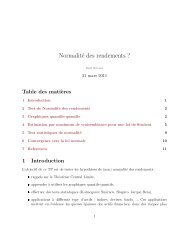
![[pdf] sujet - Yats.com](https://img.yumpu.com/51163493/1/190x245/pdf-sujet-yatscom.jpg?quality=85)
